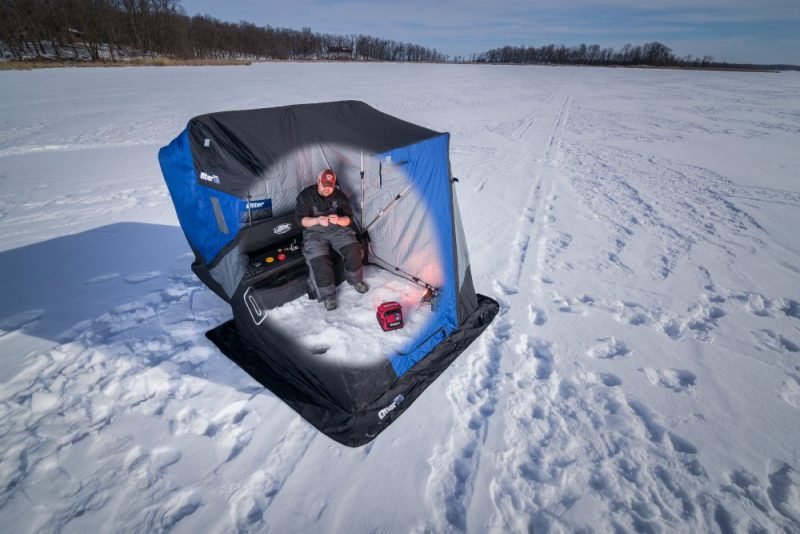Which Ice Shelter System is Right for You?
Joel Nelson 12.08.17

In the ice belt, there are two types of anglers: One type owns a shelter, and the other waits until spring to wet a line. Visit your local fishing hole during winter, and you’ll see only a handful of folks out on the open ice sitting on 5-gallon buckets. Pick a day where the mercury flirts with zero, and you’ll see nary a soul out and in the open air. Much of that phenomenon has to do with the technological advances in portable flip-style ice shelters, along with the advent of more economical hub versions. All of these designs have the same goal — to keep you more comfortable while out ice fishing.
Permanent houses these days occupy a larger and larger portion of the ice-scape, but everyone has a different budget when it comes to their ice fishing passions. For those of you interested in a portable option, there’s a big fork in the road these days between the flip-over type of shelter and the hub-style ones, with the latter definitely leading in terms of price point. That said, don’t let cost alone be the factor that decides what you fish out of when the wind howls and temperature plummets.

Gear-Haulers
Both shelter styles are effective at keeping the wind off of your back, but that’s where the trail splits. Flip-style shelters, and their built-in sled, provide a means of transport for all your gear, as well as a home-base for hole hoppers. Whether you slide out the extendable supports of the shelter and set-up shop at a single location, or you simply use the shelter portion as a means to park on fish only once they’re found, flip-style shacks offer the ultimate in flexibility while out on the ice.

They’re also the more durable solution overall, especially if you’re towing your equipment with a snowmobile or ATV. For those that traverse great distances with an ice machine, it’s a compact unit that aids in your mobility and flat-out offers more features. Hence the higher price-tag.

To Tow or Not to Tow?
Hub-shelters, while being price leaders, are also more lightweight without the attached sled and hardware. If you will be hand-towing your shelter, especially any distance, there’s a lot of weight savings to be offered in a small hand sled holding your packaged hub house. They can also be quite spacious, and great solutions for families. If you need to hold as many bodies as possible in a shelter, a large hub-style house may be in your future. You supply the sled and seating, but get a great deal of square footage for the money. However, with no attached sled or supports, ice-anchors must be deployed in windy conditions to keep it on the ice.

Given their relative low cost, I know a good deal of anglers that keep a hub-shelter in their towable flip-style while out fishing. They have it on hand for larger groups and can split off from the main group while still maintaining comfortable fishing conditions.
No matter which type of shelter has your attention, stick to the 4 S’s and you’ll be rewarded with quality and comfort:
Structure: Look closely at the framing within your shelter of interest. If a hub, does it feel sturdy and fit tightly into the hub devices? Can you rotate the hub device left or right to effectively tighten or loosen the fit of the shell over the frame, or is it fixed in one position? For flip-style shelters, what kinds of frame materials are being used? I prefer those with square aluminum frames to prevent binding, twisting and collapse, while shaving weight from the final product.

Shell: The highest quality hubs these days have high loft insulation standard as part of their shelter. For both flip-style shelters and hubs, you’re looking for as few seams as possible, and very little light penetration. Pin-holes and see-through spots on seams equal more moisture transfer and condensation, all while providing less loft and air trapping capability. Avoid this at all costs, and look for a shell that has high loft and floating layers that ultimately equal better insulation and a warmer end product.
From here, those interested in a flip-style shelter should look a little further:
Seating: Look to the overall comfort of the seating system by first sitting in it, but don’t stop there. Look underneath and see what it’s made of. Heavy steel options are durable and cheap, but add precious pounds to the final product. Bench seats are great options for adding kids or smaller fishing buddies along for the ride, while bucket seats provide the ultimate in individual comfort. Bench seats should fold and stow conveniently, while bucket seats should swivel a full 360 degrees, do so quietly, and also flip up to be able to get at your gear underneath.
Sled: This is going to be the foundation of your entire shelter, so don’t skimp for something flimsy. Roto-molded sleds are considered more durable than those thermally stretched over a mold, as they have even thickness of plastic distributed at all points of the product. That’s especially important for the corners or front of the sled that attacks the ground. Also, look to how items are attached to the sled. Tow bars that are bolted through the sled create pressure points and individual opportunities for failure, with molded hitch pockets being a more premium option.
Though we’re very used to products these days with life-cycles measured in months, there’s every reason to expect that a high-quality shelter should last you as many as 10 years or more if properly cared for. Stick to those 4 S’s in your selection process and you’ll be rewarded no matter which style of shelter suits your way of ice fishing best.


